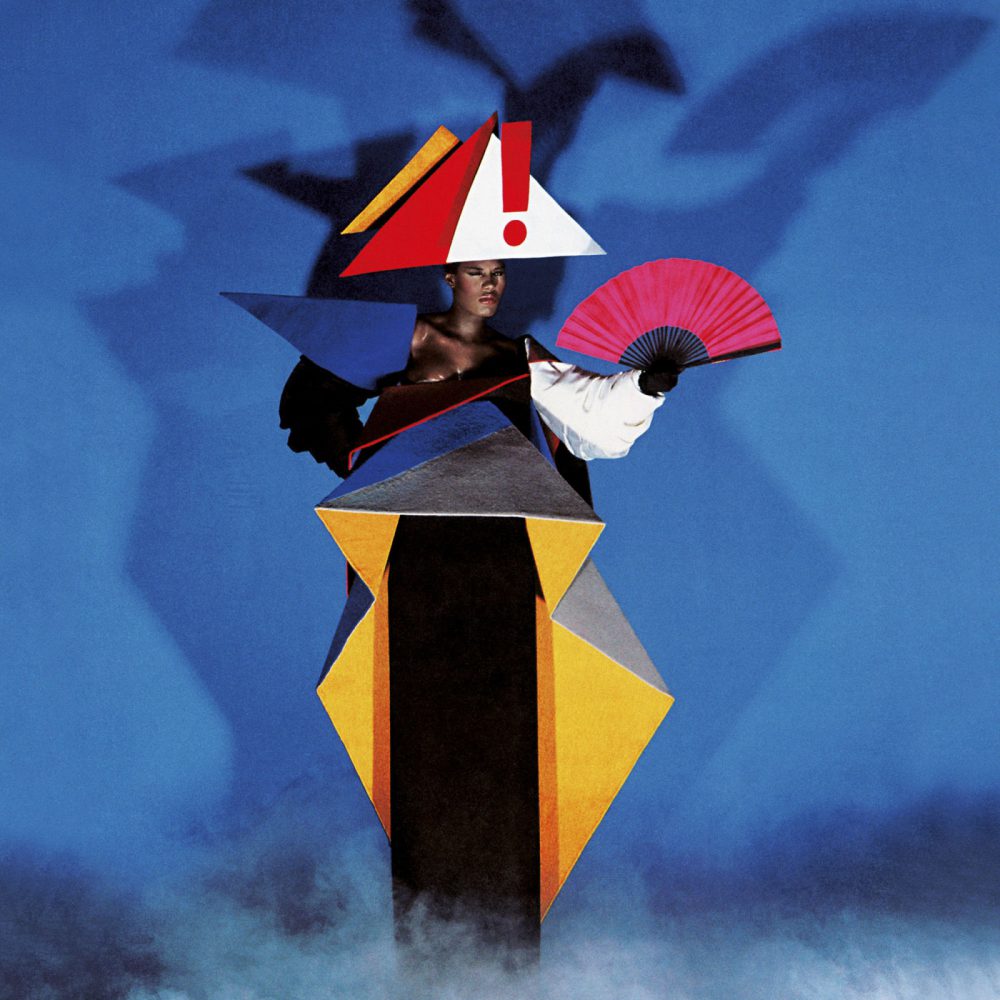Grace Jones: Strong without Permission
Sultan Isham reflects on their parallel journey with Grace Jones and shares a video recording of a recent performance dedicated to Jones.

Grace Jones in 1979, wearing Jean-Paul Goude’s constructivist maternity dress, created when Jones was pregnant with their son. Image via Harper’s Bazaar.
Here I am, sitting on the roof of my Creole cottage in the Sixth Ward of New Orleans. I can see pretty much the whole city from my roof, but somehow my neighbors can never see me. As I’m creating an outline for this essay to declare my love for Grace Jones, I time-travel through my past. I conceptualize this piece visually, as one might an exhibition, putting the mental images in order to display the healing power of storytelling. I begin to observe the many metaphorical storms that I have weathered to find my strength and true voice. I’m blasting a playlist of Jones’ music, dancing my heart out, and return to a time I haven’t been in years, my childhood.
I can recall one of the first times I heard of Ms. Grace Jones. My parents, who are very religious, were listening to a television broadcast of a minister by the name of Noel Jones. We went to church twice a week, so any time I didn’t have to hear about my being damned to hell, I used as a recess. I tuned in to a conversation about his “crazy” sister who was this international star. Grace Jones was born into a strict Christian family filled with ministers and women who stayed in their place. What she wore as a child was regulated, and she had to conduct herself in a way that would keep the people around her comfortable. She was a minister’s daughter so she had the additional burden of maintaining the reputation of her strict Pentecostal family. She endured many physical beatings because of her nature and her defiant behavior. I immediately felt a kinship to her, being in that same upbringing—being black and clearly two-spirit.
I have always known who I am, and hearing about her story excited me and frightened me at the same time. I was inspired to know that one day I might become free from this bondage—of being forced to go to church and of having to pretend to be someone else—and also terrified because I knew that my relationship with my parents would change. Unlike Jones, I was terrified of disappointing my parents. Because they were excellent providers, I was afraid of their judgement and thought they would abandon me if I couldn’t live to their standards. To escape that fear I practiced the violin in my closet, muffling the voice I wasn’t liberated to use and creating my own secret fantasy world.
Sultan Isham performing Grace Jones’ “I’ve Seen That Face Before (Libertango)” at M. Sani Art Gallery, New Orleans.
I can’t recall Jones appearing in my life again until high school when my household finally came into the age of the Internet. I could finally feed my affinity, learning as much as I could about her. Growing up, I wasn’t allowed to listen to secular music or watch most television programs, so I went to my hidden place to summon the spirit of Grace Jones, to both feel like a woman and look like a man. One of the first songs I consciously remember loving by her was “I’ve Seen That Face Before (Libertango).” As a classically trained violinist, I especially loved it because she samples a famous tango piece by Argentine composer Astor Piazzolla. I remembered playing his music on the violin because he was one of the few non-classical composers I was allowed to play. I loved the story Jones created of being followed by an unknown entity. I eventually dove into her filmography, mesmerized by her role as a vampire stripper named Katrina in the ’80s cult classic Vamp. She had a completely different look in every scene, and she created each look herself. Though she doesn’t have a single line in the film, I was captivated by how she could communicate so much with just the look she carries in her eyes. I still frequently rewatch the strip routine.
After living in upstate New York for five years—surviving a break-up and being laid off from my first job post-undergrad—I eventually went “home” to my father’s house in a small town in Georgia. I was terrified to return because of the lack of authentic acceptance I experienced from my family because of my sexuality, my gender expression, and my new spiritual awareness. I felt I had no freedom and was an embarrassment to my family. During this period I was listening to Jones’ most recent album Hurricane, which inspired my exodus from my father’s house. It’s a story of rebellion, breaking free while still maintaining the love and pride of where you come from. My family has always been proud of my academic and musical achievements, even when the person behind the work couldn’t show their face.
Through these cycles of leaving, returning, and finding home, I learned the difference between liberation and freedom. Now I am living my life as a self-sustaining performing artist, creating my own platform while breaking every rule. Liberation is defined as the act of setting someone free from oppression, while freedom is the state of not being enslaved. Liberation is asking permission from the one who holds the “beast” captive, while freedom is an unapologetic snatch of worthiness to live one’s birthright, not a privilege. Breaking this cycle is my purpose, and what I continue to learn from Jones is to be strong without permission.



